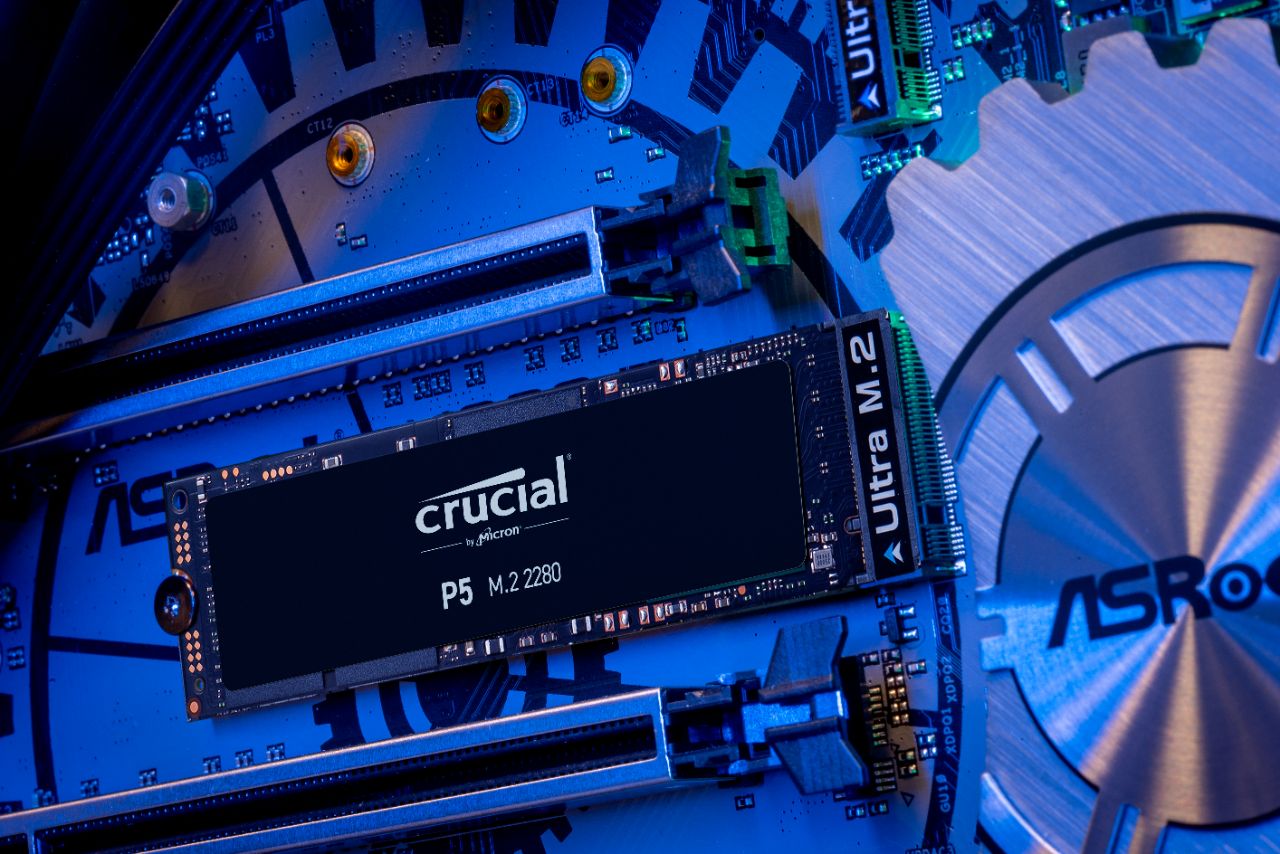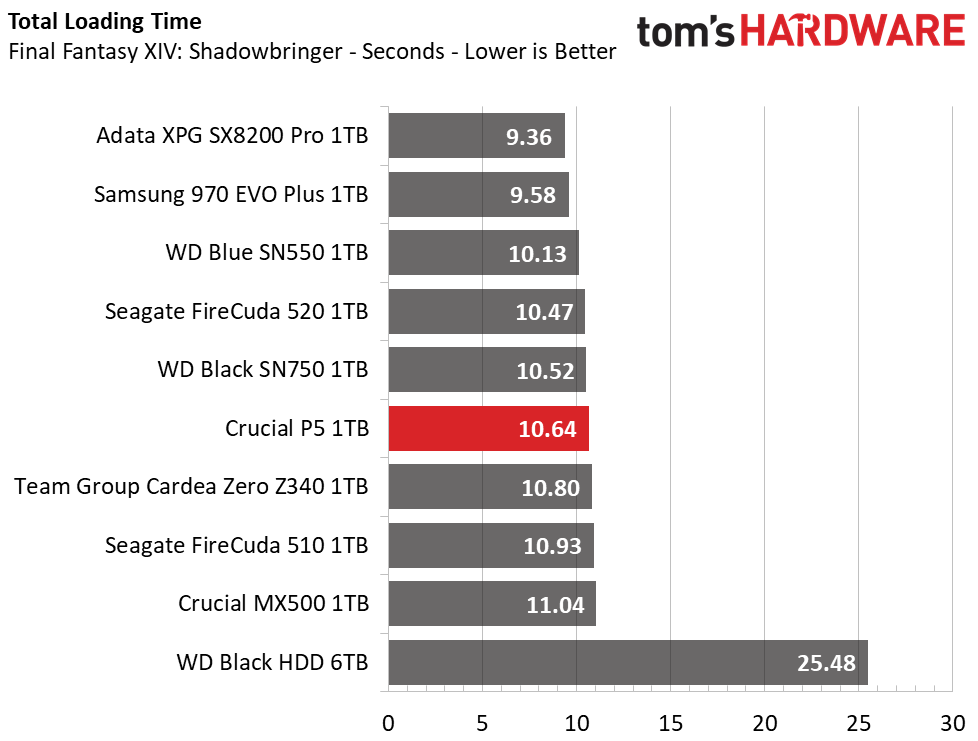Why you can trust Tom's Hardware
Crucial P5 (1TB)
RATING: ★★★ ½
PROS
+ Competitive pricing and specs
+ Hardware-based AES 256-bit encryption
+ Available in capacities up to 2TB
+ Blacked-out aesthetics
+ 5-year warranty
+ Software suite
CONS
- Lower than average performance
- High heat output
- Runs hot and lacks heat spreader
OUR VERDICT
Crucial’s P5 is the company’s first PCIe 3.0 x4 NVMe SSD with hardware-based AES 256-bit security, but performance falls short of competitors.
Get Tom's Hardware's best news and in-depth reviews, straight to your inbox.
Comparison Products
Since it is the top dog from Crucial, we pit the P5 against some of the best SSDs from each manufacturer. Adata’s XPG SX8200 Pro is one of our top value recommendations, but Samsung’s 970 EVO Plus is a beast that can sustain heavier abuse, even more than the WD Black SN750, which we also included.
From Seagate and with both featuring Phison SSD controllers, we added in the FireCuda 510 and 520, the latter having a faster PCIe 4.0 x4 based Phison E16 for higher performance. Additionally, we threw in Team Group’s Cardea Zero Z340, which has the latest E12S controller along with Micron’s latest 96L TLC as well as cheaper alternatives like WD’s Blue SN500, Crucial’s MX500, and a 7,200-RPM HDD for some extra perspective on the absolute difference interface and media type makes.
Game Scene Loading - Final Fantasy XIV
Final Fantasy XIV Stormbringer is a free real-world game benchmark that easily and accurately compares game load times without the inaccuracy of using a stopwatch.
Crucial’s P5 delivers competitive game load performance, but it isn’t the most responsive SSD of the bunch. With an average score of roughly 10.6 seconds, the P5 is more similar to the other co-processor based Phison SSDs than the all R5 core competition. Adata’s SXPG SX8200 Pro and Samsung’s 970 EVO Plus both put the P5 to shame with load times that beat it by over a second.
Transfer Rates – DiskBench
We use the DiskBench storage benchmarking tool to test file transfer performance with our own custom blocks of data. Our 50GB data set includes 31,227 files of various types, like pictures, PDFs, and videos. Our 100GB includes 22,579 files with 50GB of them being large movies. We copy the data sets to new folders and then follow-up with a reading test of a newly written 6.5GB zip file and 15GB movie file.
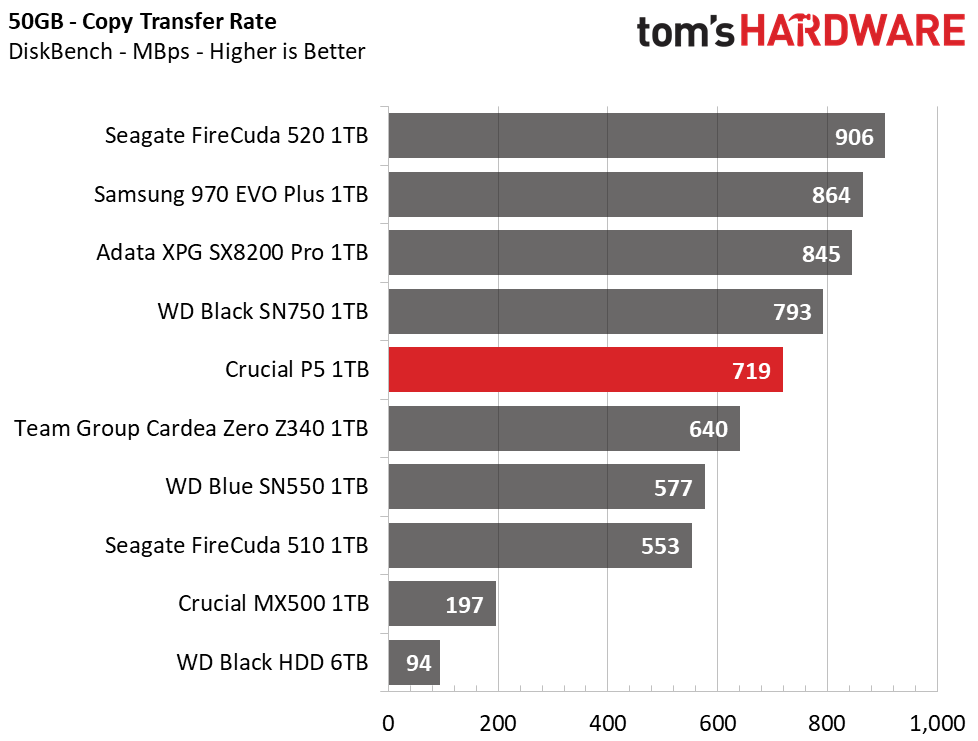
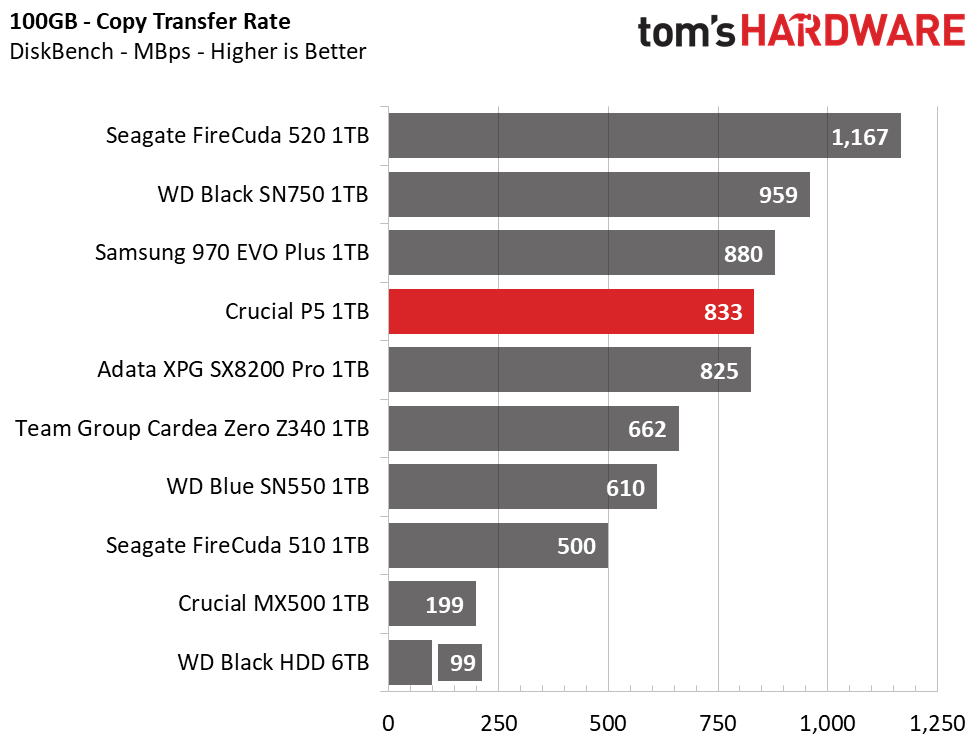
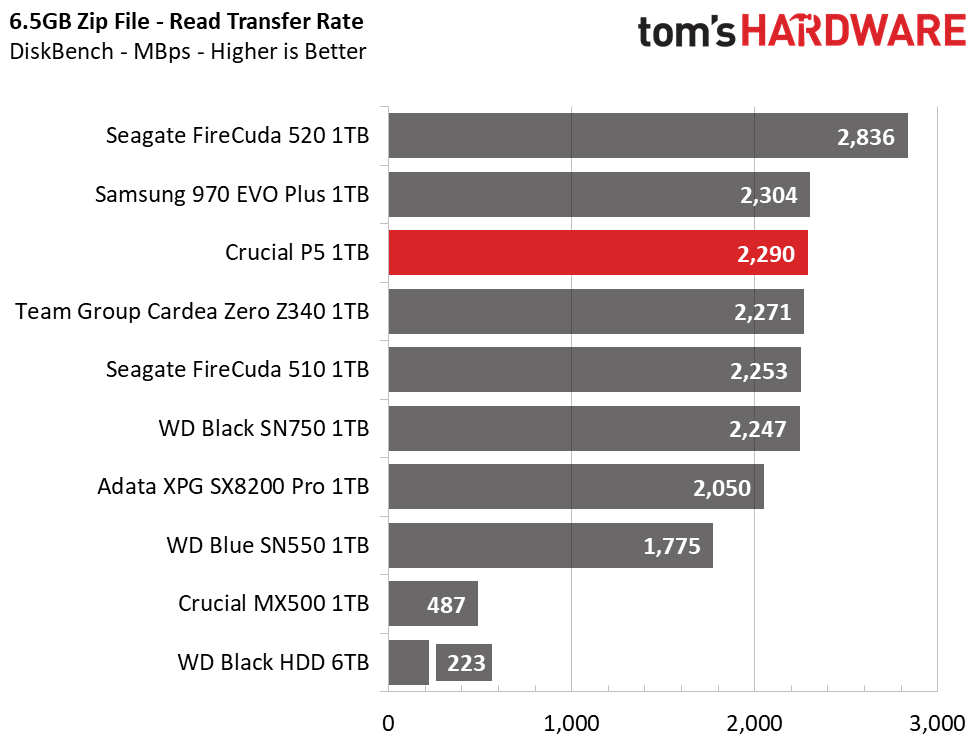
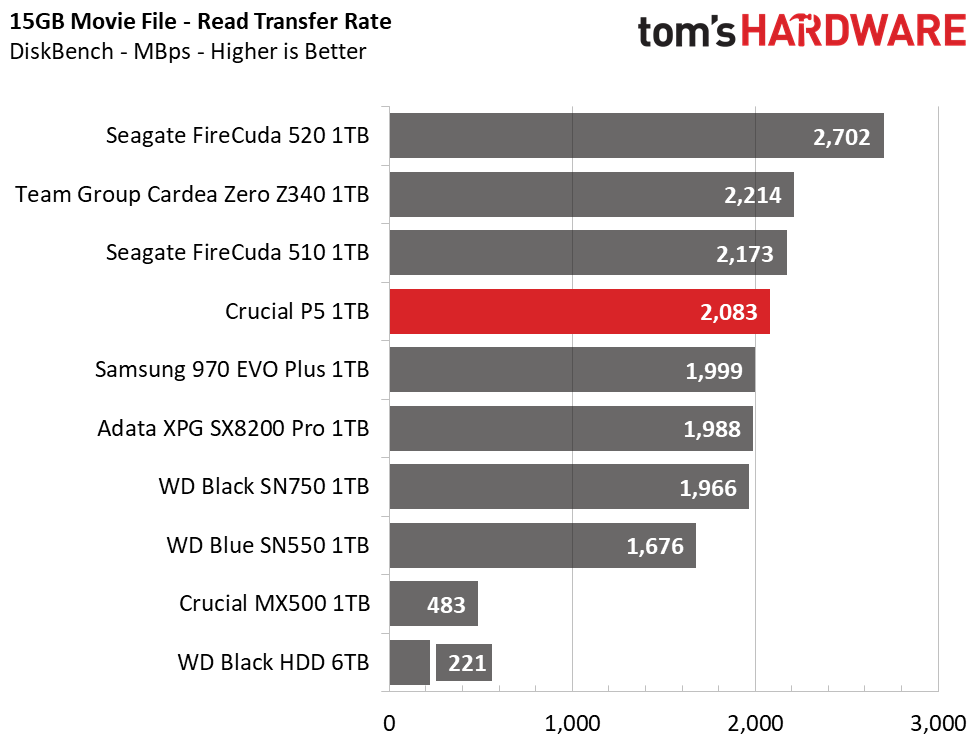
Large file transfer performance is fairly good, but again, not quite as good as the best SSDs in the market. Crucial’s P5 landed in the middle of the scoreboard under our copy workloads. Adata’s SX8200 Pro with the dual-core SM262EN powering it trades blows with the P5 during the 50GB and 100GB transfers. Thanks to its newer, 96L TLC NAND, the P5 outperforms the SX8200 Pro in sequential read performance by 100-200 MBps, however.
Trace Testing – PCMark 10 Storage Tests
PCMark 10 is a trace-based benchmark that uses a wide-ranging set of real-world traces from popular applications and common tasks to measure the performance of storage devices. The quick benchmark is more relatable to those who use their PCs for leisure or basic office work, while the full benchmark relates more to power users.
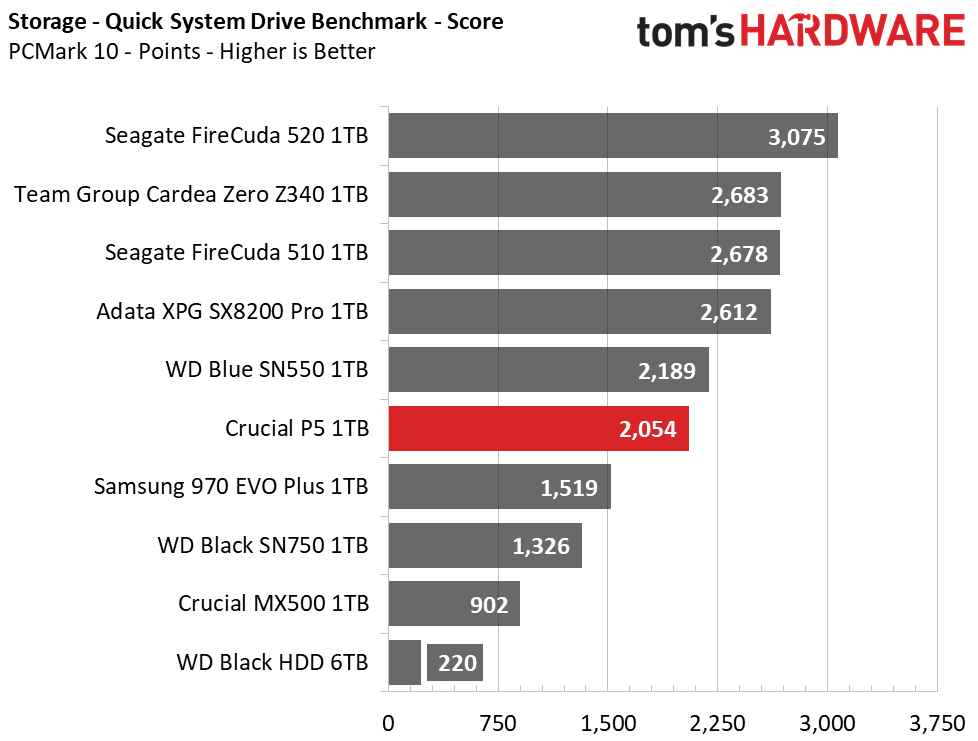
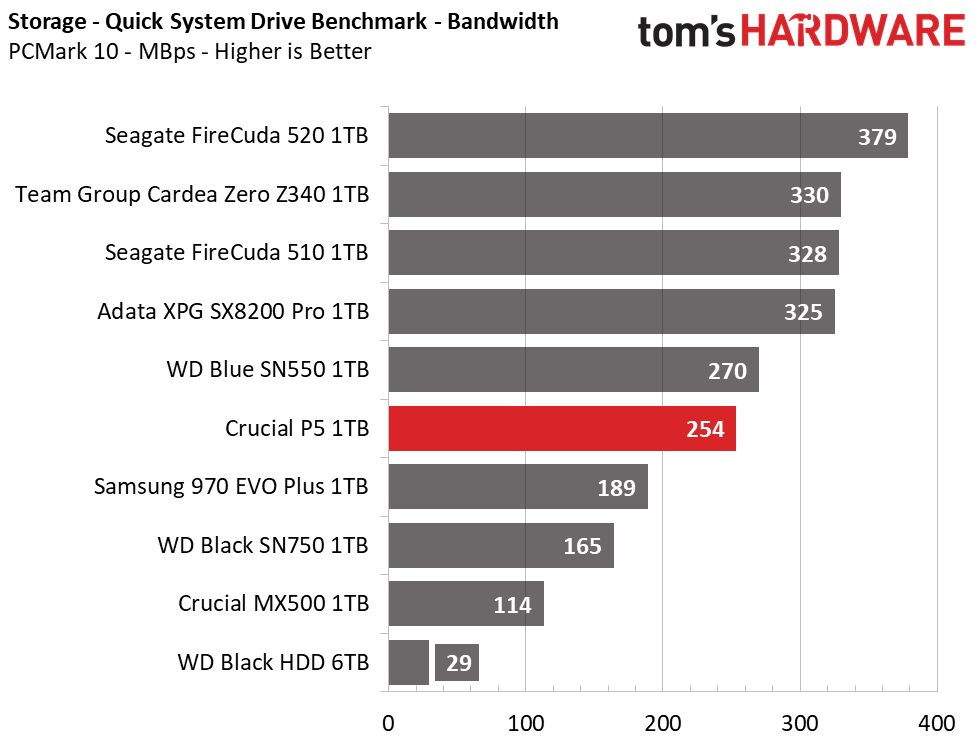
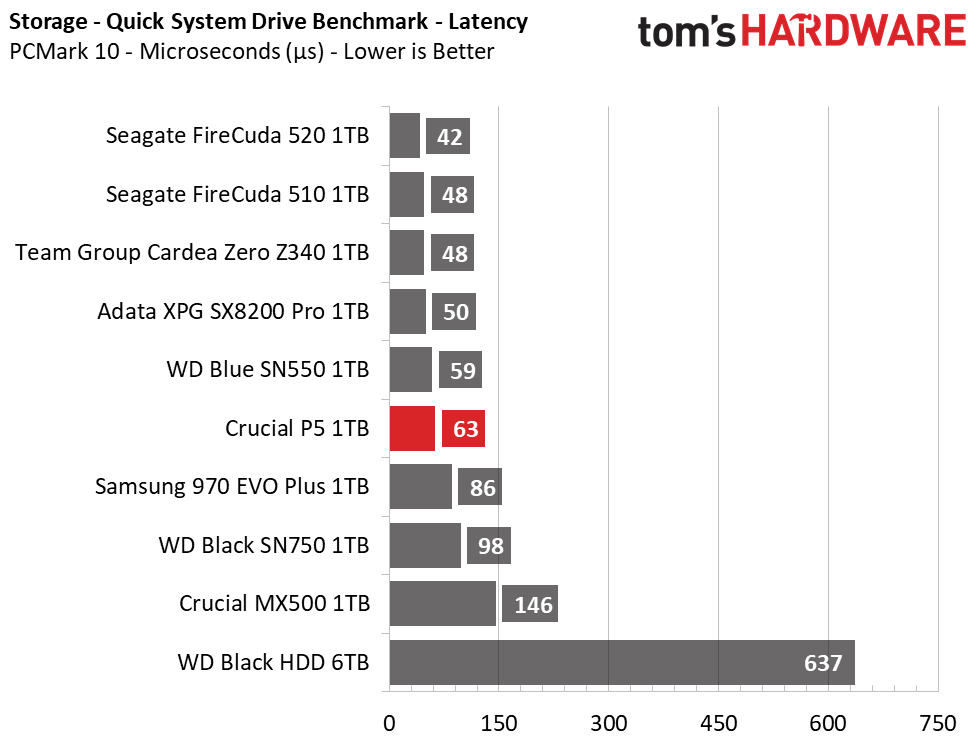
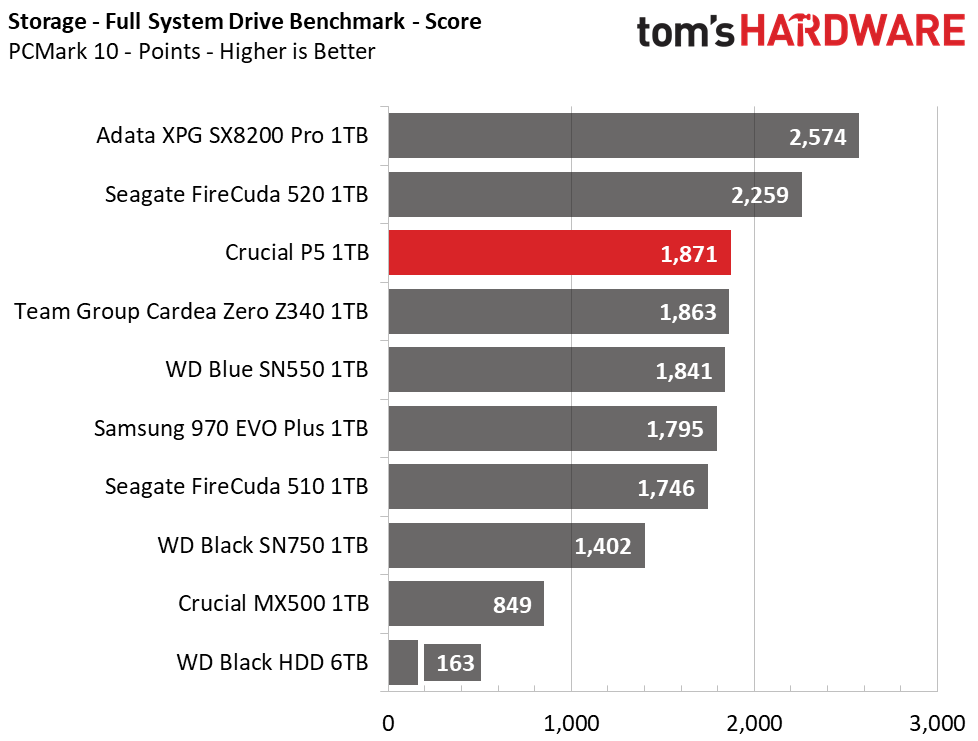
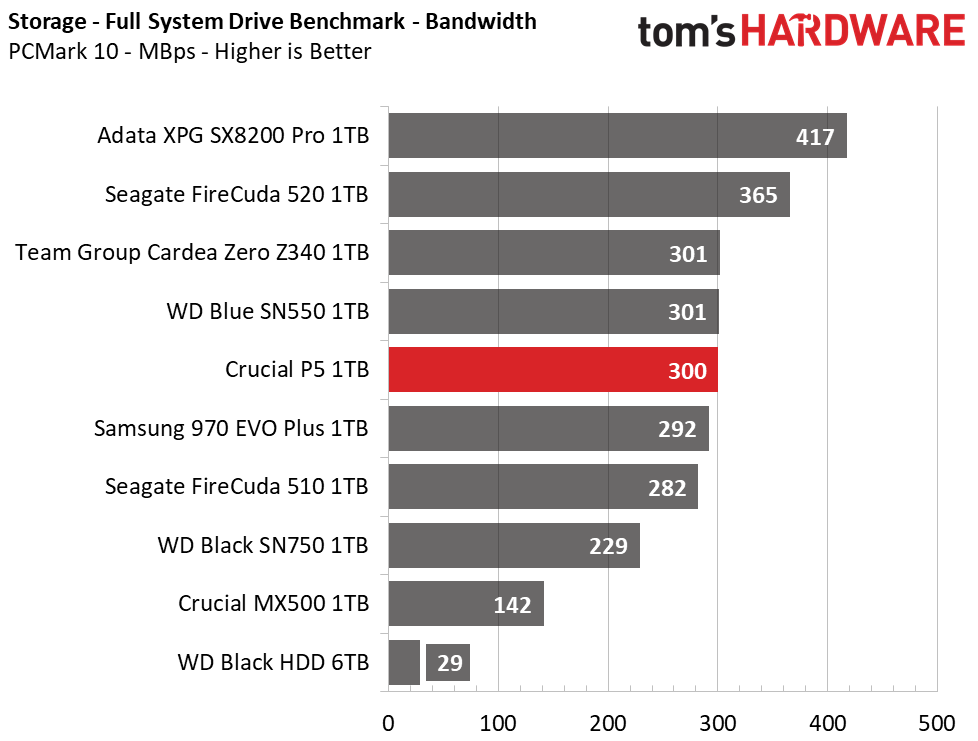
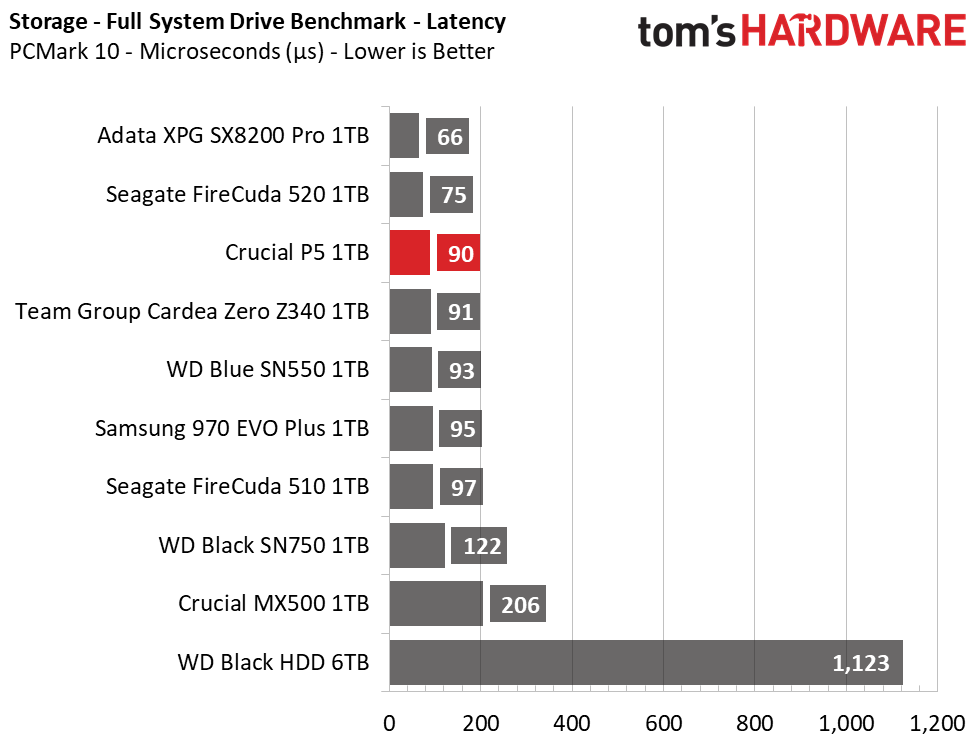
With another rather average score, Crucial scores sixth place in the Quick System Benchmark. WD’s DRAMless SN550 outperforms it by a few points overall, but it can’t hang with the Crucial once the heavy workloads hit it. Crucial’s P5 moved up the scoreboard to third place when the going got tough under the Full System Drive Benchmark. However, while Crucial’s newest SSD did well to outperform the Phison E12S-based Team Group Cardea Zero Z340, and even the Samsung 970 EVO Plus, Adata’s SX8200 Pro ranks ahead of them all in this consumer-centric workload.
Trace Testing – SPECworkstation 3
Like PCMark 10, SPECworkstation 3 is a trace-based benchmark, but it is designed to push the system harder by measuring workstation performance in professional applications.
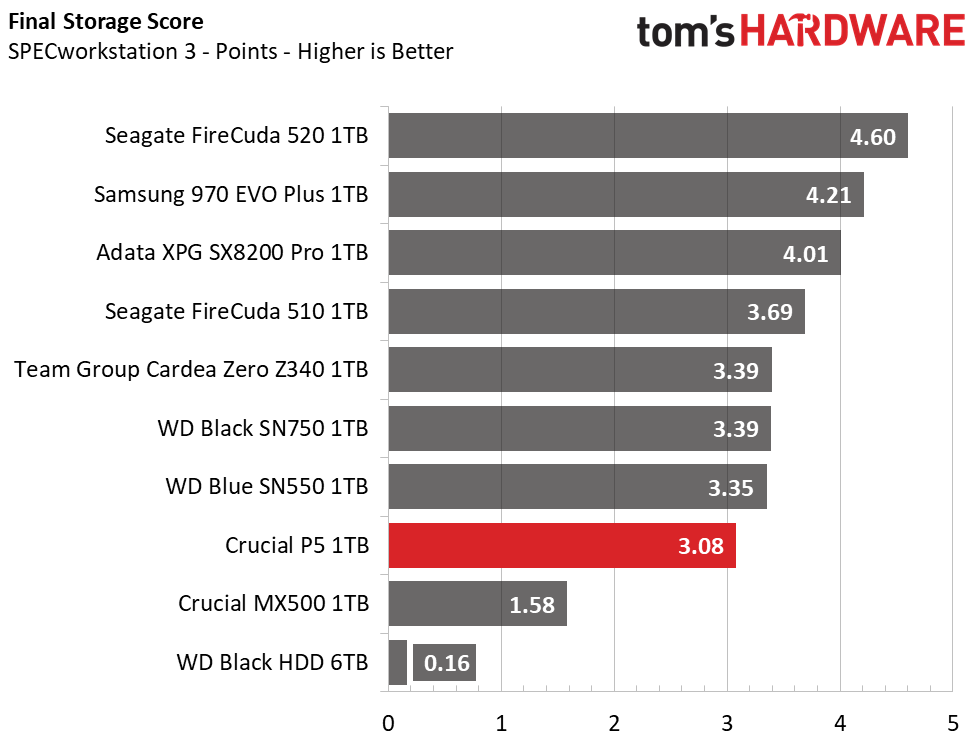
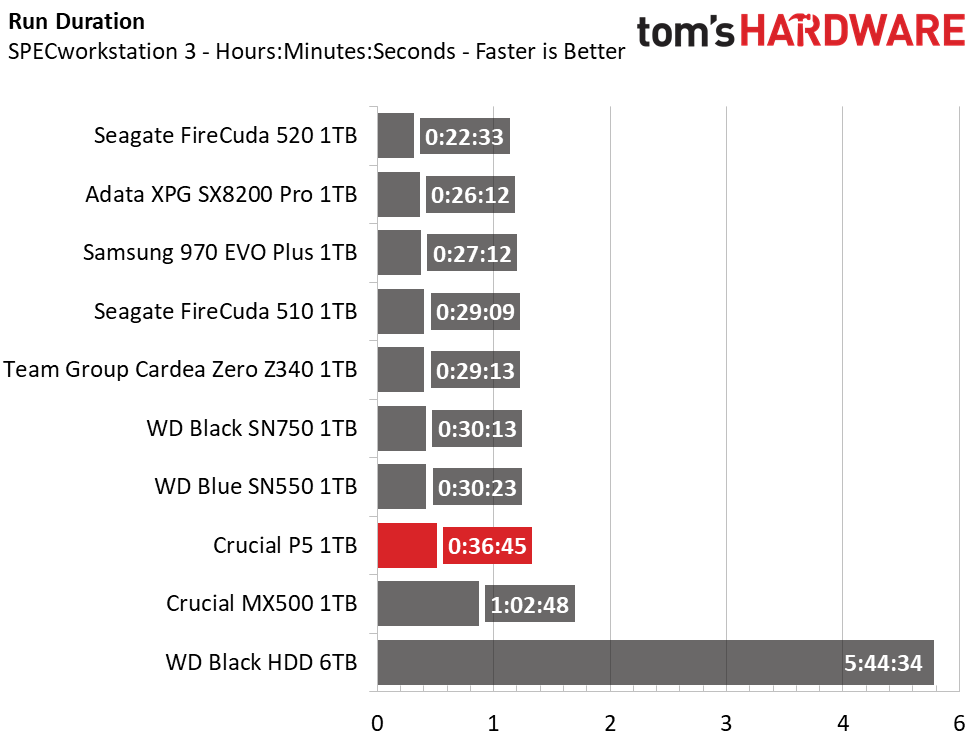
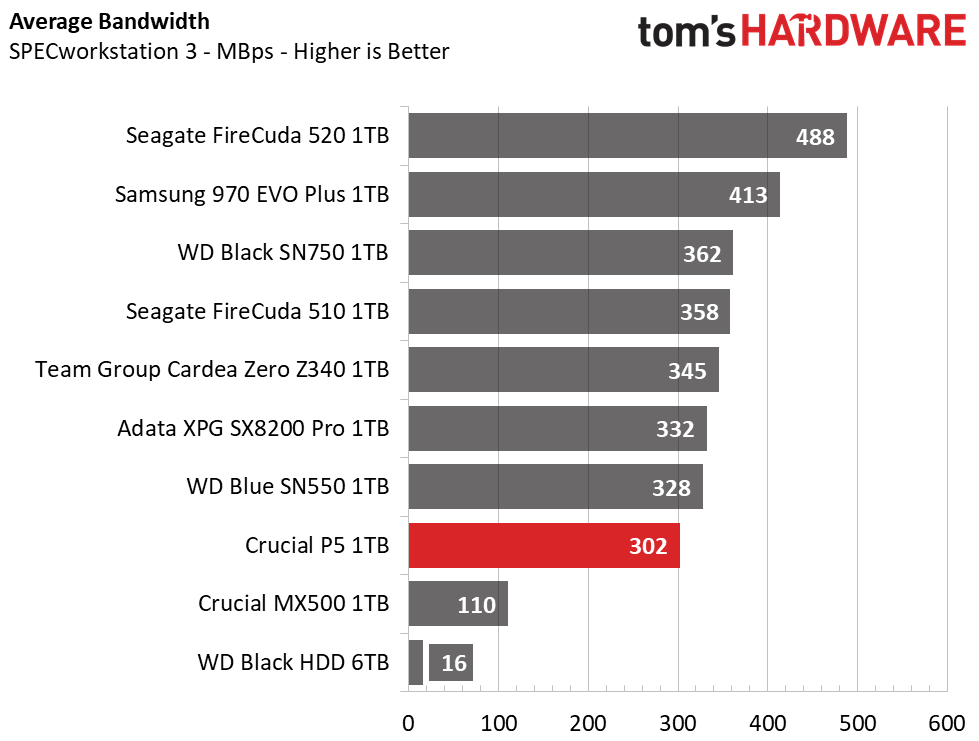
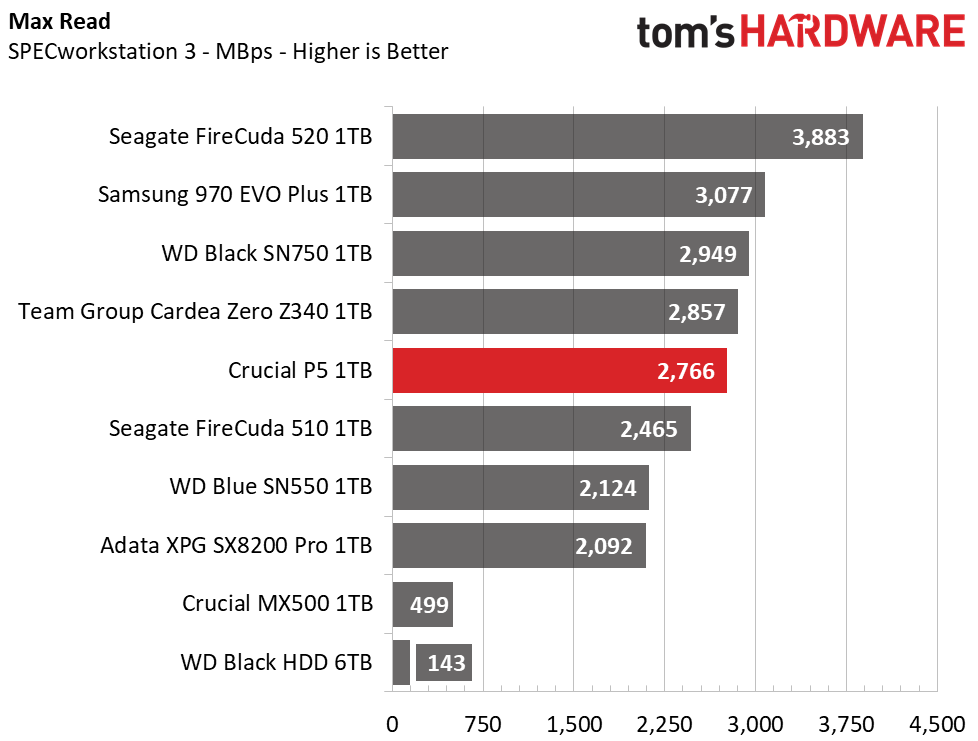
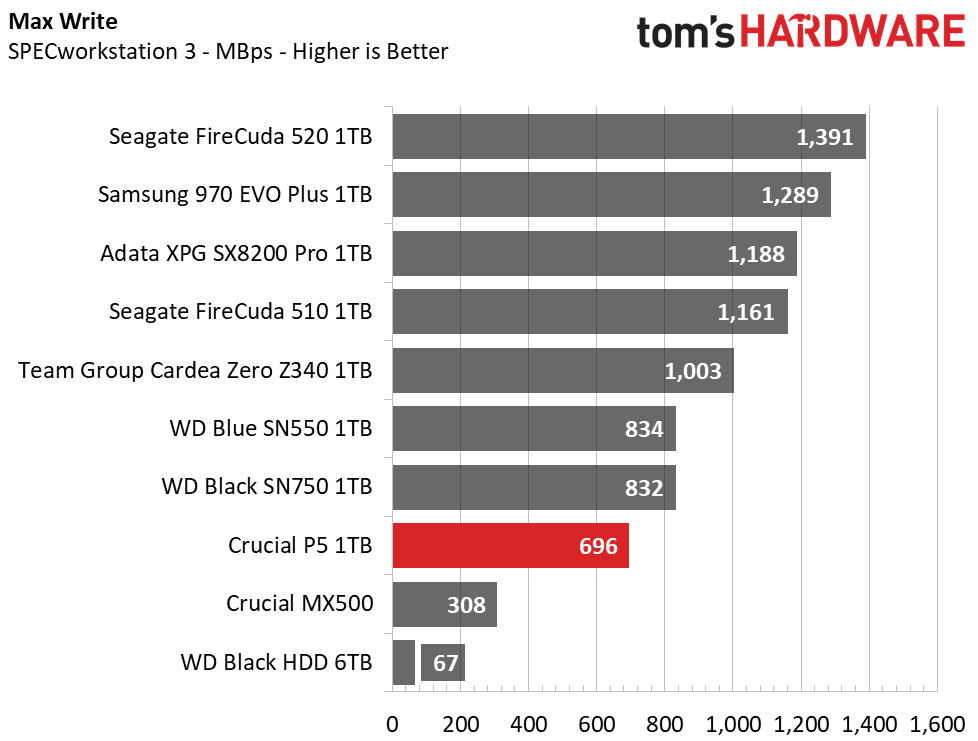
Although it managed to deliver twice the performance of the MX500, completing the benchmark in half the time, we were very surprised to see how poorly the Crucial P5 compares to the competition. After multiple rounds of testing, Crucial’s P5 placed eighth in SPECworkstation’s storage benchmark, trailing most mainstream and high-end SSDs.
When being hammered with these professional workloads, the P5 lagged the Adata XPG SX8200 Pro and Seagate’s FireCuda 520 by over 10 minutes. Like the WD Black, the P5 also had low max write speed. However, it was even lower than the DRAMless WD Blue SN550.
Synthetic Testing - ATTO / iometer
iometer is an advanced and highly-configurable storage benchmarking tool while ATTO is a simple and free application that SSD vendors commonly use to assign sequential performance specifications to their products. Both of these tools give us insight into how the device handles different file sizes.
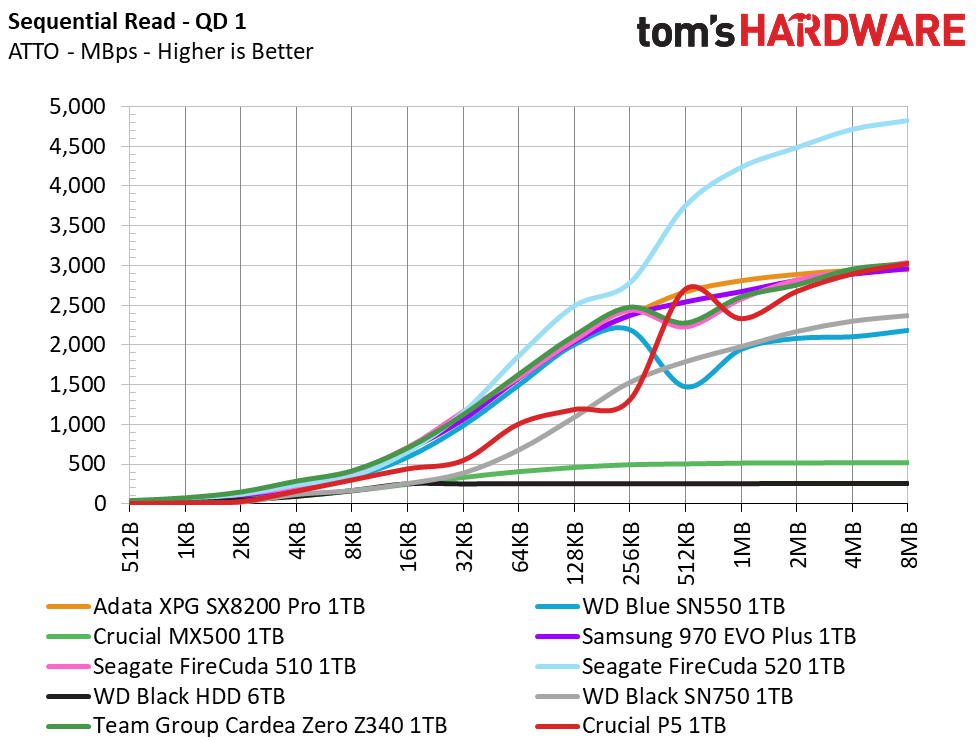
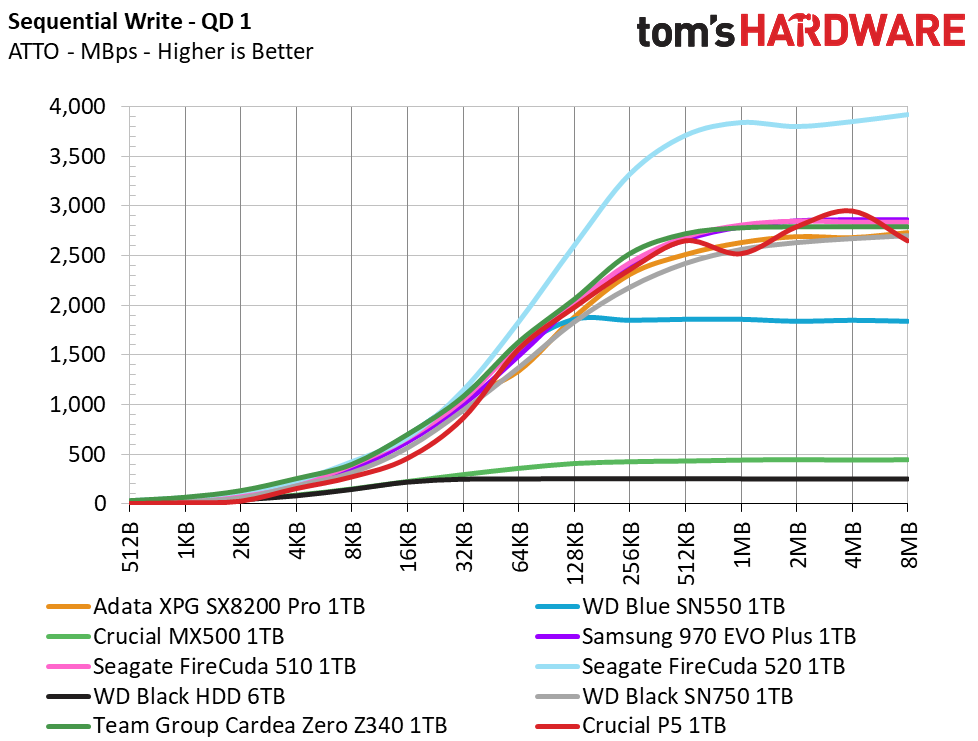
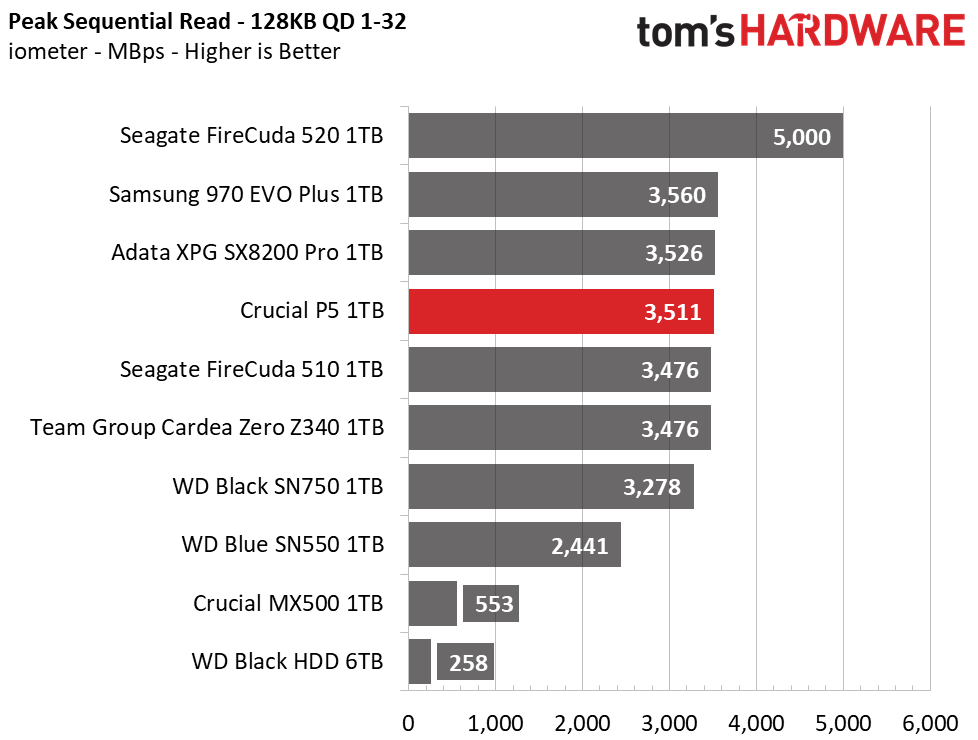
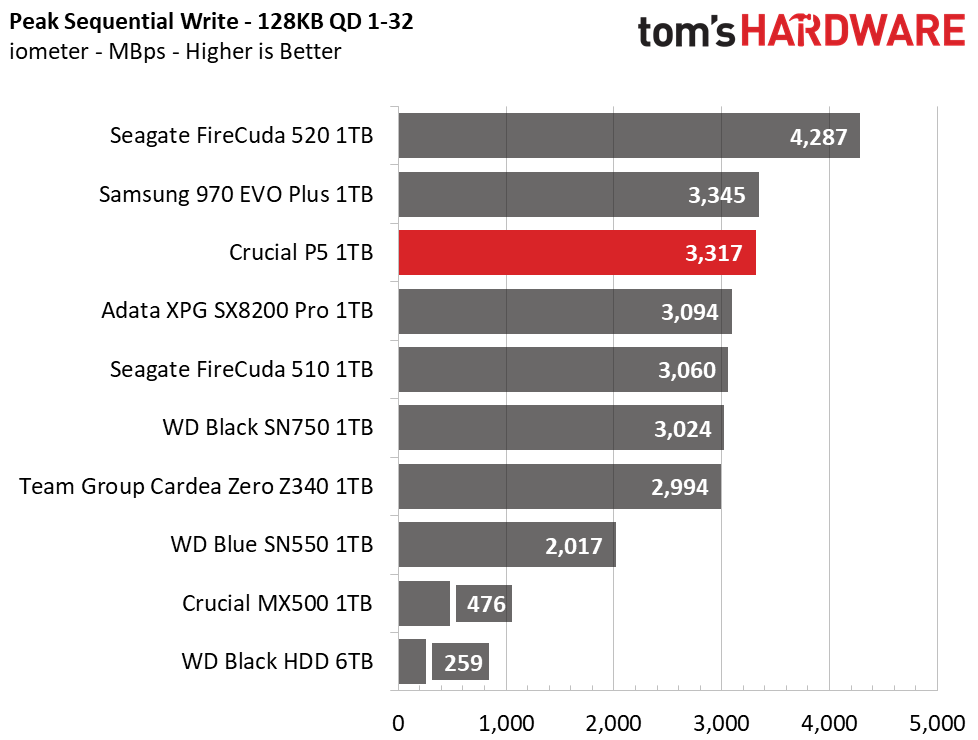
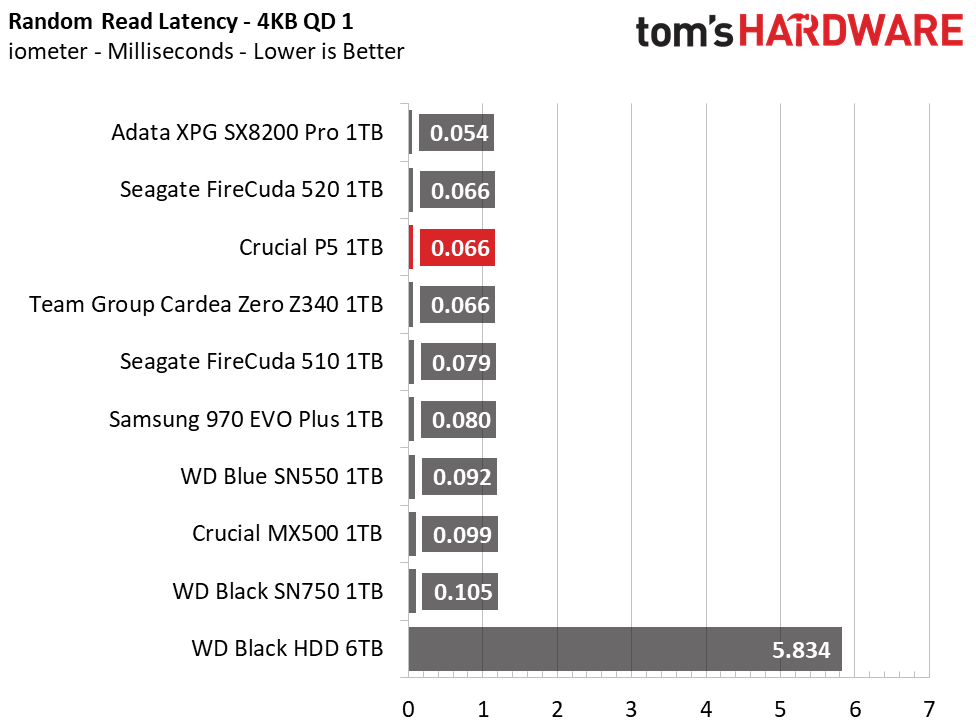
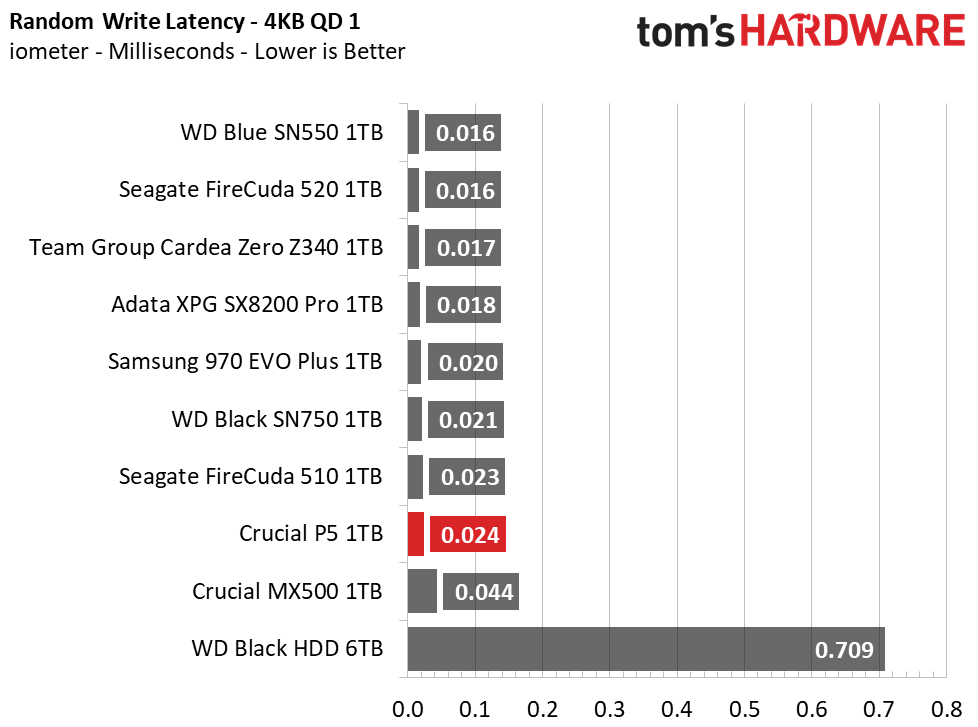
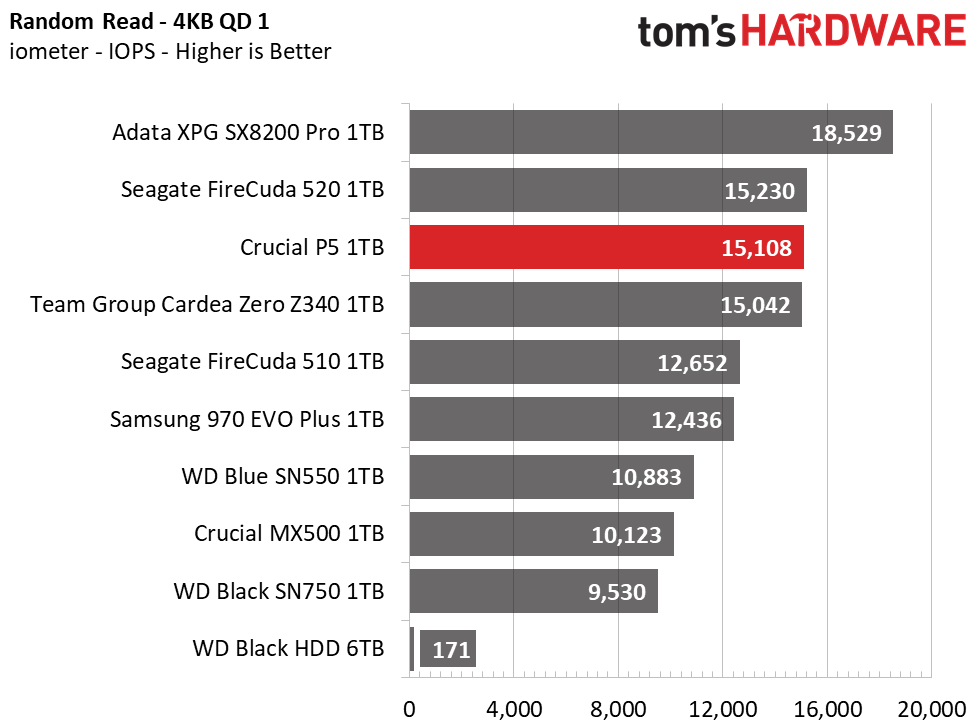
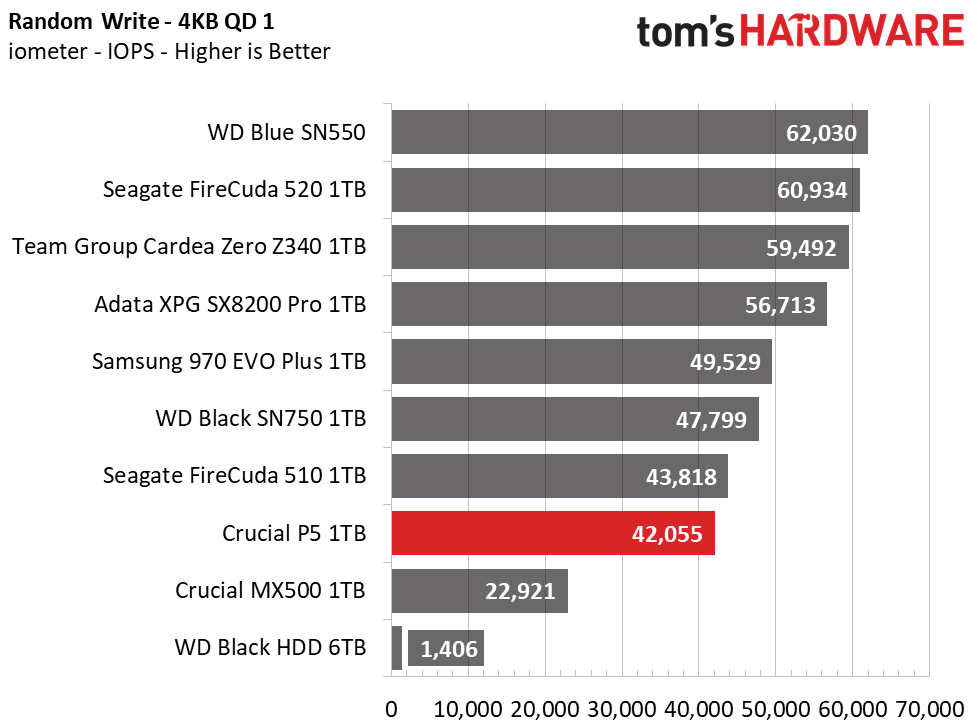
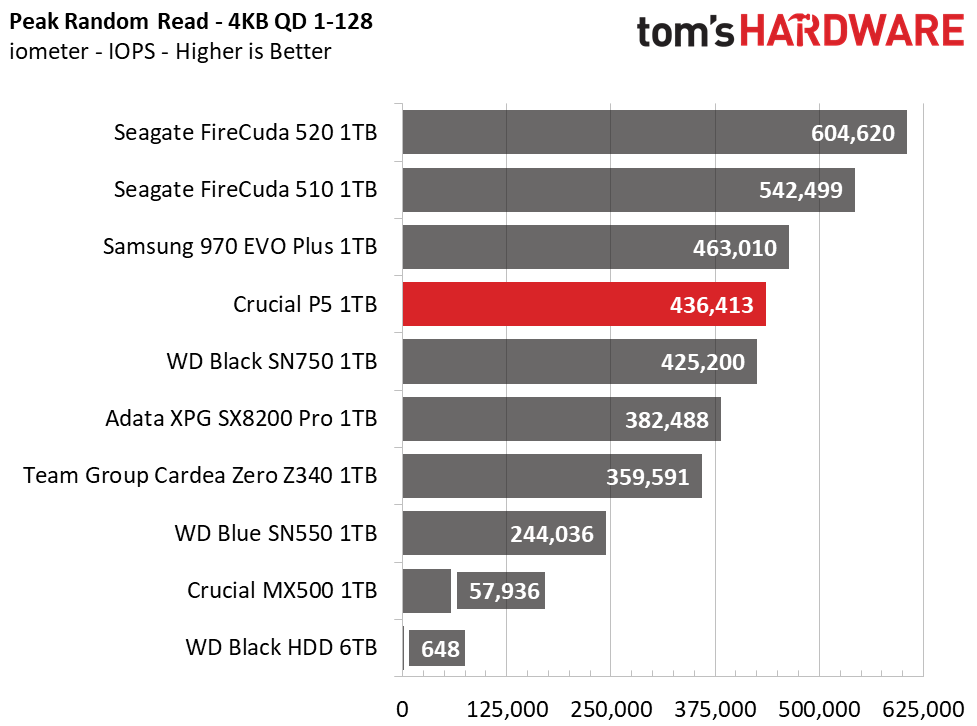
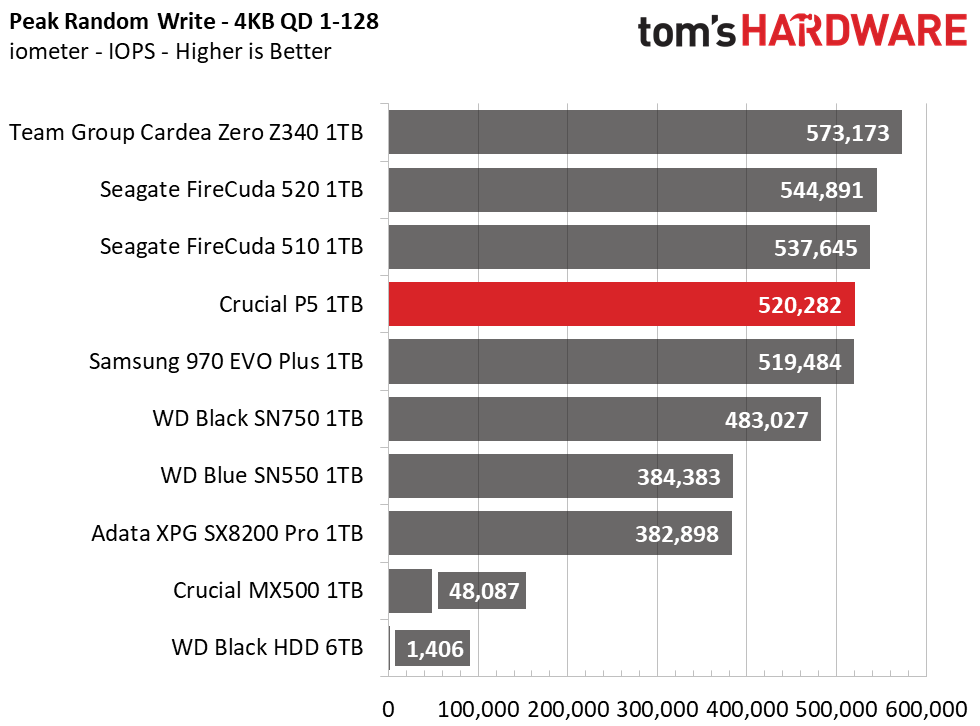
In ATTO, we tested Crucial’s P5 at a QD of 1, representing most day-to-day file access at various block sizes. The P5 isn’t as responsive as the rest of the devices with the smaller file sizes. It isn’t until the 512KB block size and beyond that the P5 starts to get near its peak read performance.
Write performance is much better, but not consistent with the degree at which competitors are performing. We measured a peak throughput of 3.5 /3.3 GBps with iometer, although it took a QD of over 8 to reach such a high read speed with a 128KB block size. The Crucial P5’s random 4KB performance scales well and it manages to deliver the third-fastest read result at QD 1, but its write performance lags competitors.
Sustained Write Performance and Cache Recovery
Official write specifications are only part of the performance picture. Most SSD makers implement a write cache, which is a fast area of (usually) pseudo-SLC programmed flash that absorbs incoming data. Sustained write speeds can suffer tremendously once the workload spills outside of the cache and into the "native" TLC or QLC flash. We use iometer to hammer the SSD with sequential writes for 15 minutes to measure both the size of the write cache and performance after the cache is saturated. We also monitor cache recovery via multiple idle rounds.
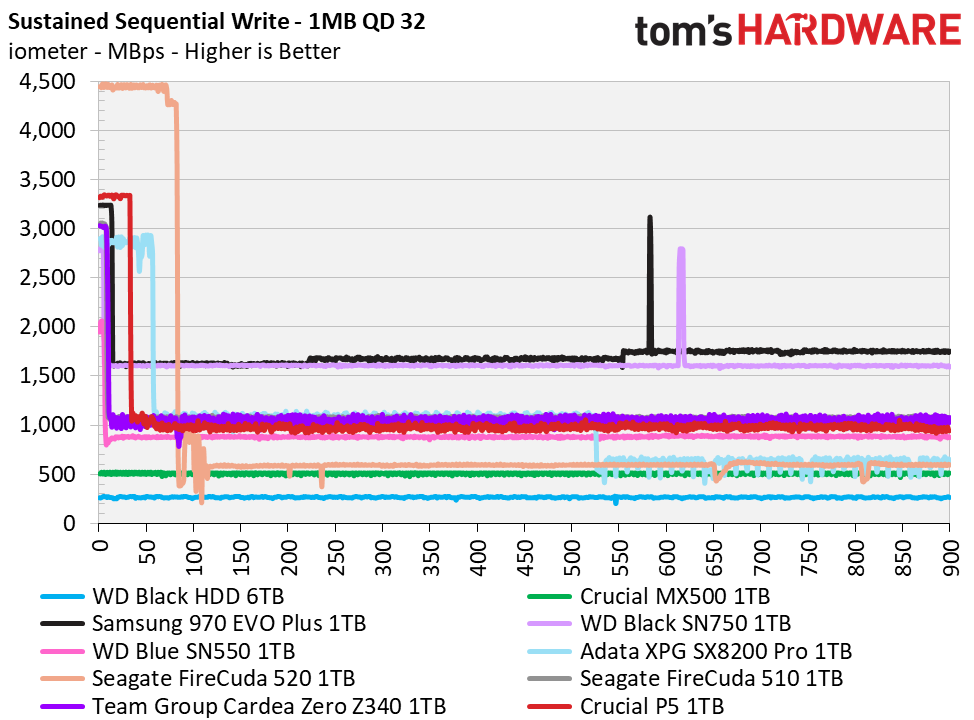
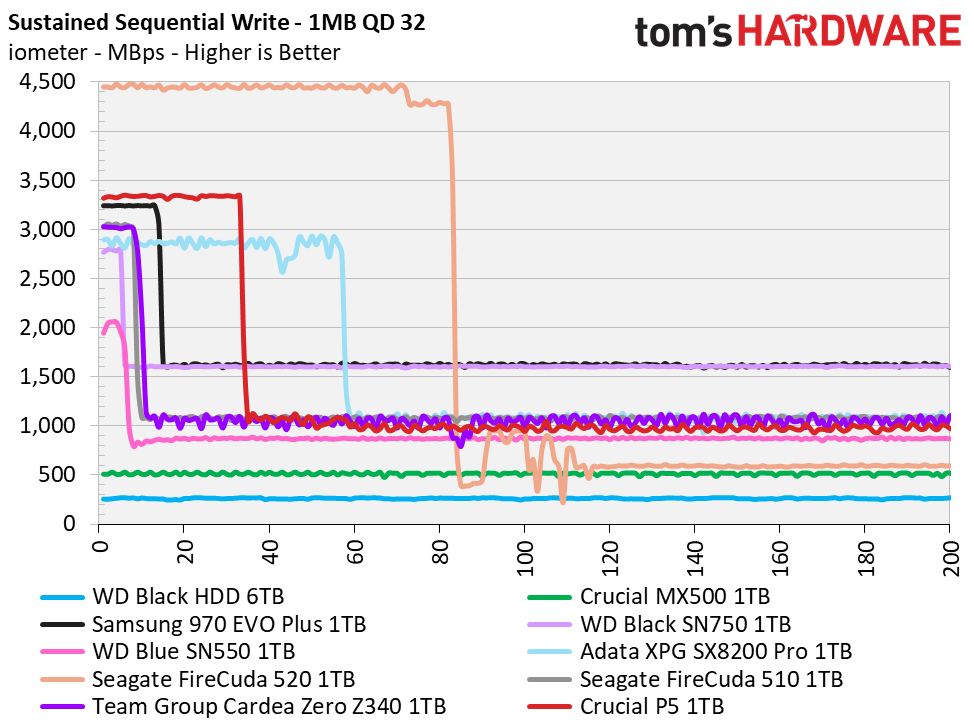
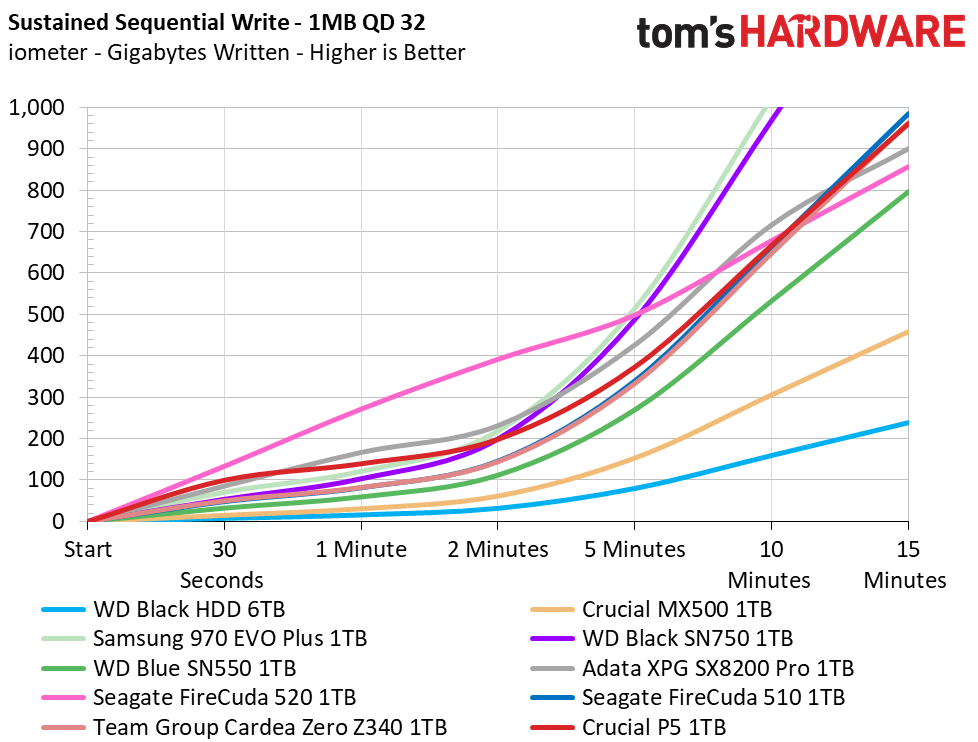
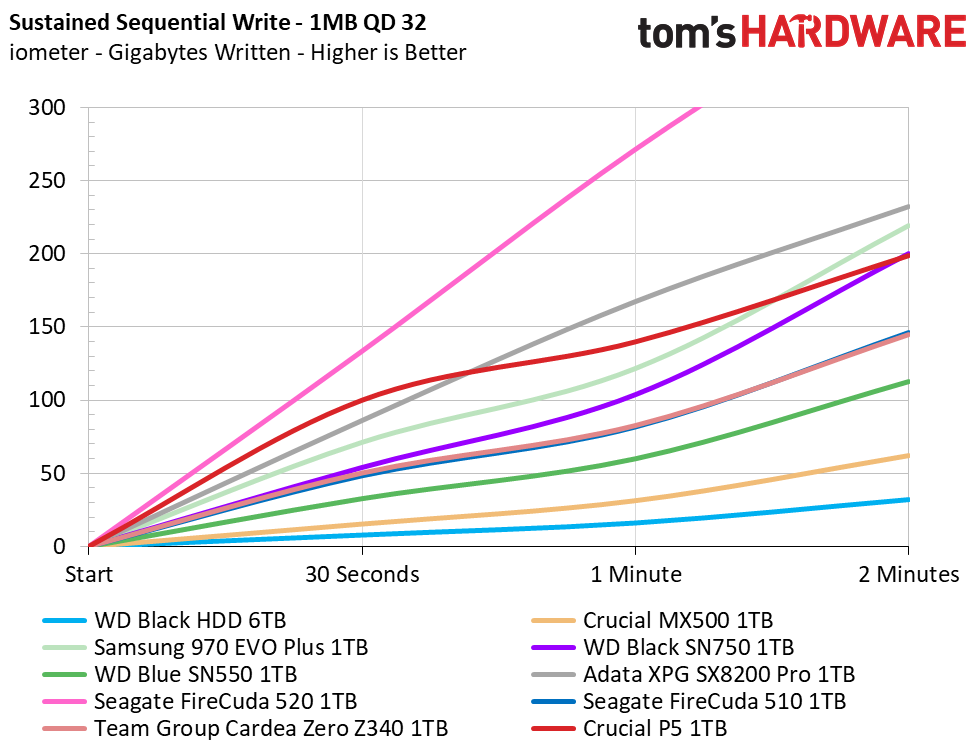
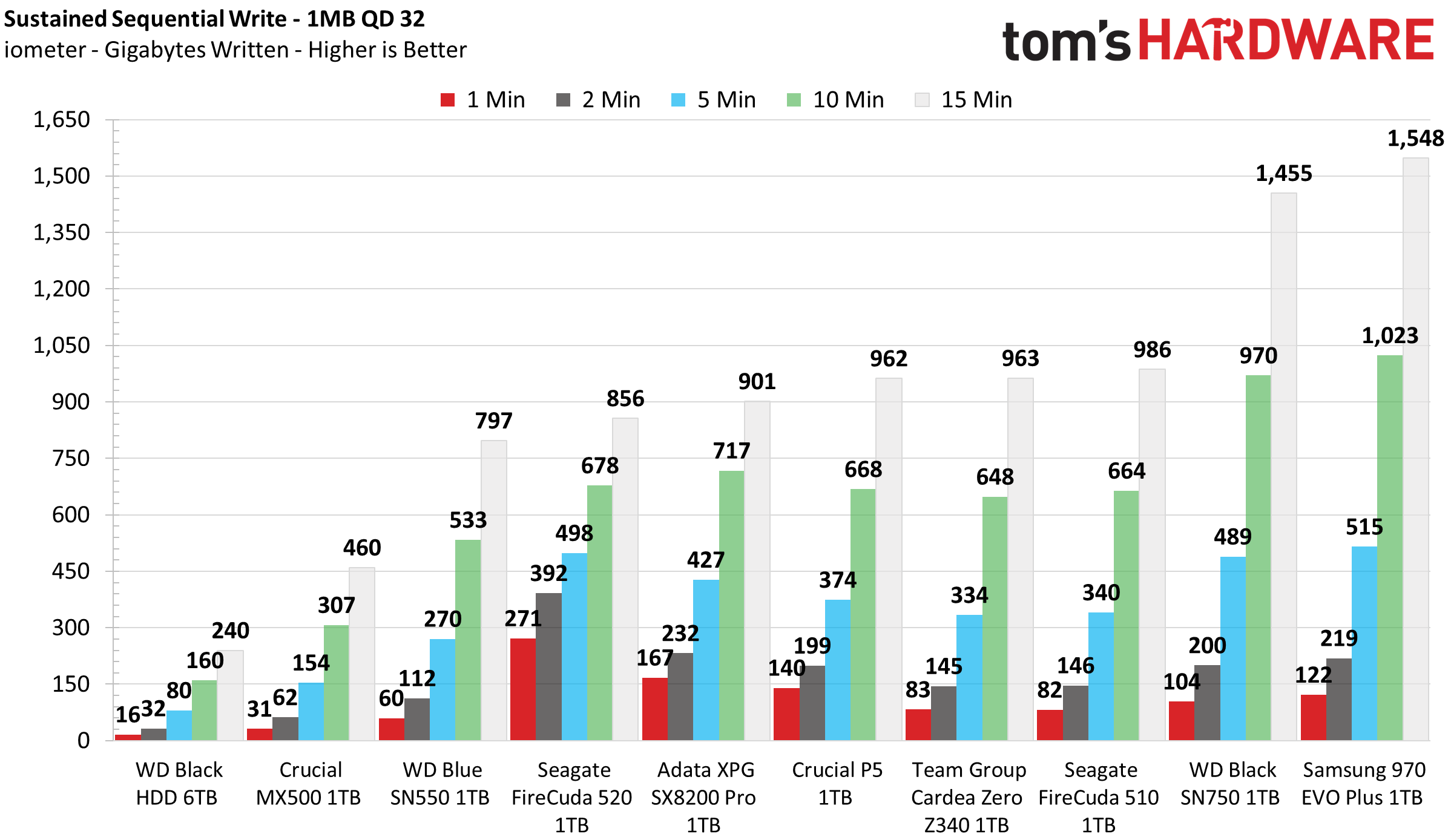
While typically we see the full SLC cache size by doing our initial 15 minutes of writing to the SSD, the P5’s SLC cache grew after we let it idle and we hit it with more writes. The initial SLC cache size measured was roughly 110GB, However, after 30 seconds of idle, the P5 wrote a total of 160GB of data at full speed and again after multiple idle rounds. It’s not only dynamic, but it’s also adaptive based on workload. So, essentially it detected the write workload and optimized the cache size for further sequential writes.
The cache on the Crucial P5 is not only interesting because it grew, but also because of the quick rate at which the P5 can recover so much cache space and make it available for new write requests. While Phison’s recovery rate is around 16GB per 30 seconds, Crucial’s P5 can recover its cache at a rate that is 10x faster thanks to some on-the-fly cache remapping rather than pure cache evacuation. However, Crucial wouldn’t get into the details on how that remapping works. With its additional co-processing power, it managed to match the Adata SSD’s cache while maintaining a decent sustained direct-to-TLC write speed, comparable to Phison’s E12 based competitors.
Power Consumption and Temperature
We use the Quarch HD Programmable Power Module to gain a deeper understanding of power characteristics. Idle power consumption is an important aspect to consider, especially if you're looking for a laptop upgrade. Some SSDs can consume watts of power at idle while better-suited ones sip just milliwatts. Average workload power consumption and max consumption are two other aspects of power consumption, but performance-per-watt is more important. A drive might consume more power during any given workload, but accomplishing a task faster allows the drive to drop into an idle state faster, which ultimately saves power.
When possible, we also log the temperature of the drive via the S.M.A.R.T. data to see when (or if) thermal throttling kicks in and how it impacts performance. Bear in mind that results will vary based on the workload and ambient air temperature.
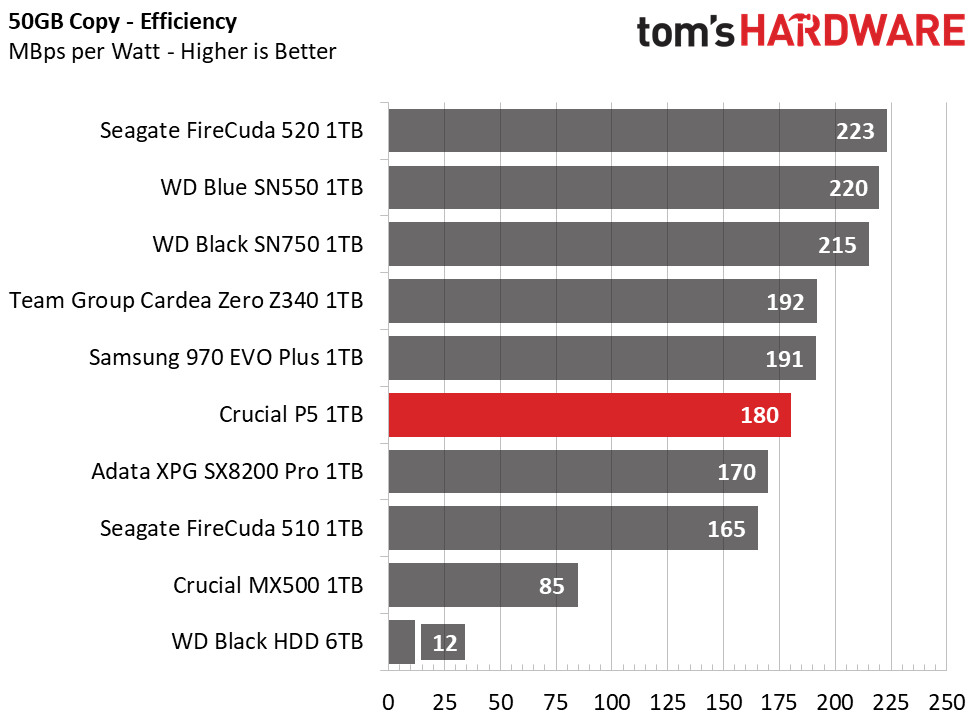
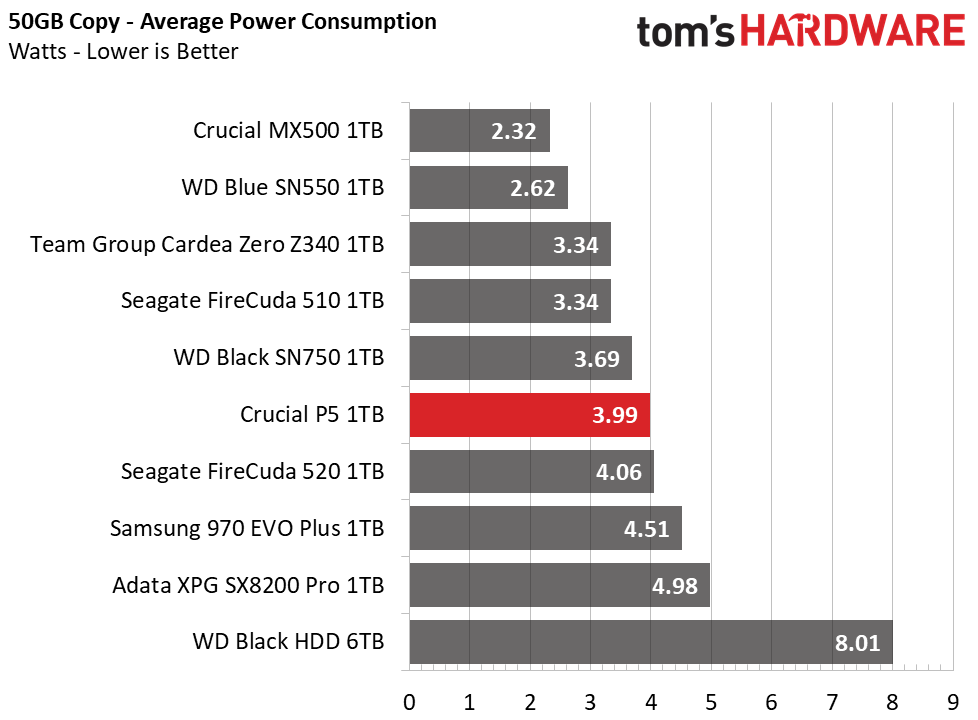
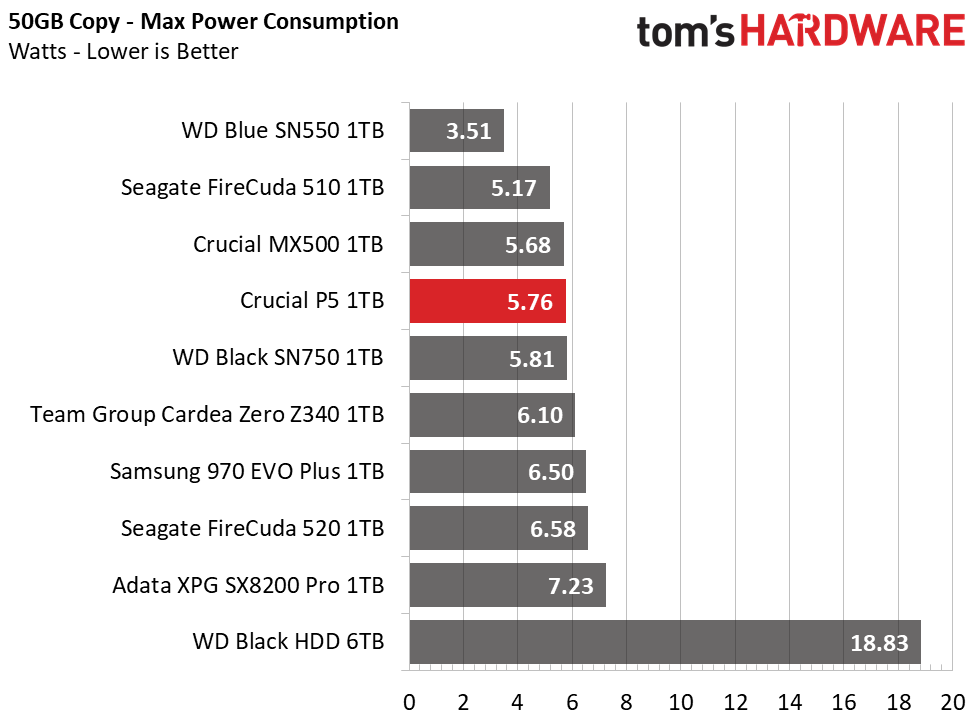
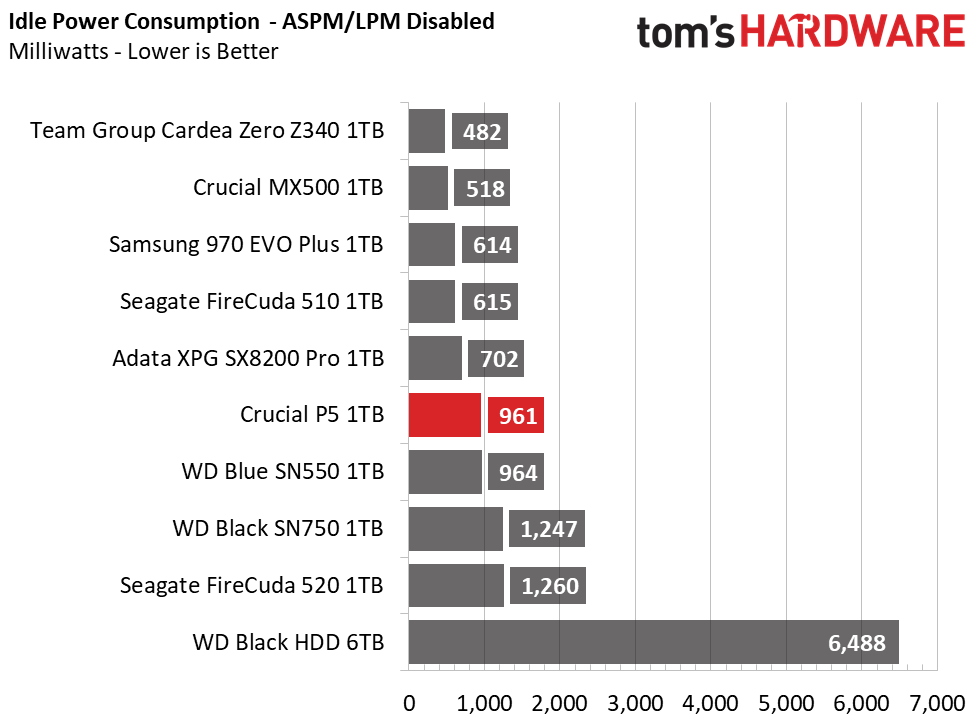

Crucial’s P5 isn’t the most efficient SSD on the market, but its power consumption is well managed. Averaging roughly 4W, it scores between the Adata XPG SX8200 Pro and the Samsung 970 EVO Plus in efficiency while copying our 50GB test folder. Idle power consumption is fairly high, but nowhere near as high as the WD SSDs on our desktop test bench.
The P5 idles rather hot, however. Even while sipping 145mW, the controller temps range from 53-55 degrees Celsius (C) at idle on an open-air test bench in a 24C room. When transferring around 350GB of data, the controller throttled after the NAND hit 70C. However, the controller reached 103C as reported by the SMART data or 90-92C via an IR thermometer, which is quite toasty. We would recommend using your motherboard’s built-in M.2 heatsink or at least give it some airflow when possible.
MORE: Best SSDs
MORE: How We Test HDDs And SSDs
MORE: All SSD Content

Sean is a Contributing Editor at Tom’s Hardware US, covering storage hardware.
-
Co BIY Should the 2T model perform better because of greater parallelism with the additional NAND packages ?Reply
Also why is the $/Gig greater at 2T than at 1T? Seems unusual. -
Co BIY I think it would be worth while to run the 1TB version vs the 2TB by placing each as a competitor into the others review heat. That way we not only see how it compares to the same size competition but how they stack up head to head.Reply
Then you can see the choices easily - The drive against the competitors and against itself.
and you get to publish hard earned data twice for more views! -
Avro Arrow From what I've seen, nothing beats the Corsair Force NVMe drive. It has a read/write rating of 4950MBps/4950MBps. Of course, it only gets those speeds with PCI-Express 4.0 so ATM only AMD can really take advantage of it.Reply -
JonnyDough ReplyAvro Arrow said:From what I've seen, nothing beats the Corsair Force NVMe drive. It has a read/write rating of 4950MBps/4950MBps. Of course, it only gets those speeds with PCI-Express 4.0 so ATM only AMD can really take advantage of it.
That may be so for sequential but the Force series does not have the highest random read/write speeds out there... -
seanwebster Reply
That's a good idea, but can get tricky. I wish we could simply update a database for easy to make charts. I will try to include the next closest capacity in with the updated capacity under test, though.Co BIY said:I think it would be worth while to run the 1TB version vs the 2TB by placing each as a competitor into the others review heat. That way we not only see how it compares to the same size competition but how they stack up head to head.
Then you can see the choices easily - The drive against the competitors and against itself.
and you get to publish hard earned data twice for more views!
Well, the 1TB Seagate FireCuda 520 and the 2TB Sabrent Rocket NVMe 4.0 are identical to the Corsair Force MP600, so they all perform the same. You can swap the names for the corsair in the benchmarks above if you want to see how it compares. Samsung's 980 PRO is now out and a few more Gen4 devices are on the way. The Phison PS5016-E16 NVMe controller powering thOse drives is no longer top dog.Avro Arrow said:From what I've seen, nothing beats the Corsair Force NVMe drive. It has a read/write rating of 4950MBps/4950MBps. Of course, it only gets those speeds with PCI-Express 4.0 so ATM only AMD can really take advantage of it. -
Avro Arrow Reply
I believe you. I know that memory is only made by a few companies like Samsung, Hynix and Micron so it would make sense that their top-end products wouldn't just go to Corsair. The Team T-Force CARDEA is pretty close too with theoretical read/write limits of 5000/4400.seanwebster said:That's a good idea, but can get tricky. I wish we could simply update a database for easy to make charts. I will try to include the next closest capacity in with the updated capacity under test, though.
Well, the 1TB Seagate FireCuda 520 and the 2TB Sabrent Rocket NVMe 4.0 are identical to the Corsair Force MP600, so they all perform the same. You can swap the names for the corsair in the benchmarks above if you want to see how it compares. Samsung's 980 PRO is now out and a few more Gen4 devices are on the way. The Phison PS5016-E16 NVMe controller powering thOse drives is no longer top dog.
Jeez, these numbers are getting so big that they're starting to lose all meaning! :D
